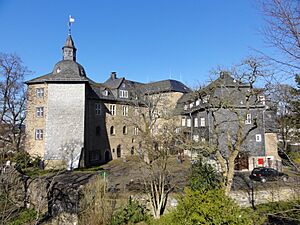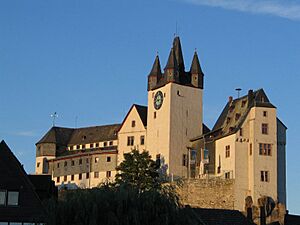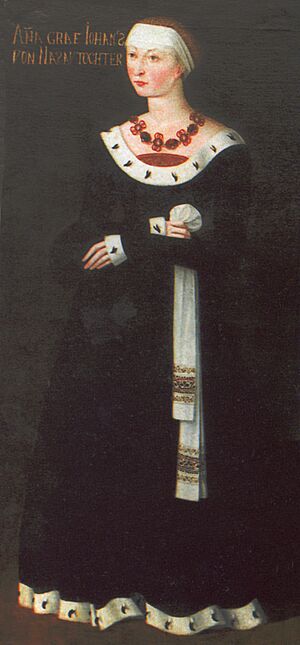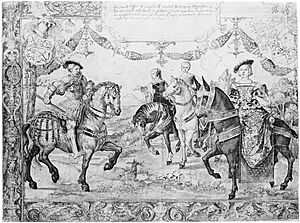John V, Count of Nassau-Siegen facts for kids
Quick facts for kids
John V, Count of Nassau-Siegen
|
|
|---|---|
| Count of Nassau-Siegen Count of Diez |
|
| Coat of arms | 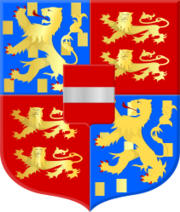 |
| Reign | 1475–1516 |
| Predecessor | John IV |
| Successor | William I the Rich |
| Full name |
John V, Count of Nassau-Siegen
|
| Native name | Johann V. Graf von Nassau-Siegen |
| Born | Johann Graf zu Nassau, Vianden und Diez, Herr zu Breda 9 November 1455 Breda |
| Died | 30 July 1516 (aged 60) Dillenburg or Siegen |
| Buried | St. John's Church, Franciscan monastery, Siegen Reburied: St. Mary's Church, Siegen 1836 |
| Noble family | House of Nassau-Siegen |
| Spouse(s) | Elisabeth of Hesse-Marburg |
| Issue Detail |
|
| Father | John IV of Nassau-Siegen |
| Mother | Mary of Looz-Heinsberg |
John V of Nassau-Siegen (born 9 November 1455 – died 30 July 1516) was a powerful noble who ruled as Count of Nassau-Siegen and half of Diez starting in 1475. He was part of the Ottonian Line of the House of Nassau, a very old and important family.
John also served as a Stadtholder (a kind of governor) for Guelders and Zutphen from 1504 to 1505. He focused mostly on managing his own lands. During his time, a big argument started with the Landgraviate of Hesse over who would inherit the rich County of Katzenelnbogen. This argument lasted for many years, even after his death.
John was very interested in helping his county's economy. He supported and encouraged mining, especially for iron. Because of his efforts, the number of iron mines grew in the Siegerland and Dillenburg areas. He also helped trade by creating rules for different guilds, like those for steel and blacksmiths, and wool weavers.
As a very religious Catholic, John built a Franciscan monastery in Siegen. He also built churches in Hadamar and Dillenburg.
Contents
Life Story of John V
John was born in Breda on 9 November 1455. He was the second and youngest son of Count John IV of Nassau-Siegen and Lady Mary of Looz-Heinsberg.
In 1472, John IV and his sons, Engelbert and John, made a plan for how their lands would be divided after John IV's death. Engelbert, the older son, would get the lands in the Netherlands. John, the younger son, would receive the lands east of the Rhine River, which included Nassau-Siegen and Diez.
Becoming Count of Nassau-Siegen and Diez
John became count in 1475, just as his father had planned. His lands included important towns like Siegen and Dillenburg. He also shared control of several areas with other noble families. His main home, or Residenz, was in Siegen.
The County of Nassau-Siegen was split into smaller areas called districts (Ämter). In each district, the count chose an Amtmann. These were local nobility members who acted on behalf of the count. They had servants to keep order and formed the main part of the army during war.
For justice, the county had a Schultheiß in most districts. The rules for justice were written down in 1498 for the Siegen and Dillenburg districts. These rules had to be read aloud to everyone each year. John also set up a special court at Ginsburg Castle to deal with serious crimes like "robbery, murder, and arson" more quickly.
The county's money system was simple. All money went into the count's personal treasury. He received payments from farms in the form of goods, like crops or animals. As money became more common, people started paying in coins instead of goods. The Rentmeister (a financial officer) became very important.
The count's regular income included taxes on land and a personal tax paid when a serf died. There was also a hearth tax paid during Lent. Special taxes were collected for emergencies. Income also came from tolls, which were often rented out. Taxes were also collected in cities on houses, gardens, and fields.
A big source of money for the Counts of Nassau was the iron toll. A document from 1470 listed taxes for pig iron, steel, and other metal products. The count's expenses included travel, court celebrations, payments for officials, and especially building projects at his castles. In 1481, John finished expanding Tringenstein Castle, which his father had started.
Soon after his father's death, John had a disagreement with Count Gerhard of Sayn. They argued about John's actions in the areas of Burbach and Neunkirchen. In 1478, they agreed on rules for buying ironstone and coal and for the metal industry. This shows John's strong interest in boosting his county's economy.
John also worked to improve trade routes. He was interested in controlling parts of the historic Eisenstraße (Iron Road). This road was important for connecting the Siegerland with other areas and creating new markets for Nassau's goods.
John was part of the Wetterauer Grafenverein, a group of counts who had special toll agreements. This group allowed goods like food, grain, and especially iron to be transported freely. This was very important for Nassau's iron trade. In 1515, new agreements made it even easier for iron from Siegerland to reach markets like Antwerp.
John had a close relationship with his older sister Anne, who lived in Celle after marrying Duke Otto II of Brunswick-Lüneburg. They often exchanged goods. Anne sent John salmon, eels, and other North Sea foods. In return, John sent her cast iron pans from Siegen.
In 1481, John successfully settled a long-standing claim by his cousin Ottilie to the County of Diez. In 1485, Ottilie's second husband, Count Oswald I of Tierstein, tried to harm John because he was unhappy with the inheritance settlement. John's financial officer, Heinrich Weiß, stopped the attempt.
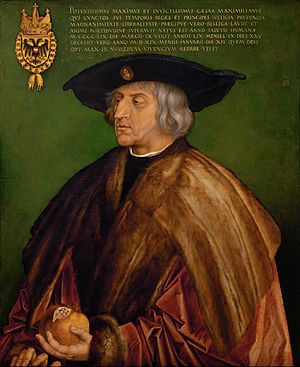
In 1485, John made claims to the Duchy of Cleves and the County of Mark. He even declared war on Duke John II of Cleves with the support of Roman King Maximilian I. However, there was no actual fighting, and the disputes were settled with some money for John. John, like Maximilian I, enjoyed medieval chivalry and tournaments. He attended tournaments in Mainz, Ingolstadt, and Ansbach.
John also stood firm against the powerful Landgraves of Hesse in a dispute with the von Bicken Family. By 1486, he made the von Bicken family subject to the Counts of Nassau, meaning they had to follow his rules.
In 1487, John's brother Engelbert was captured in a battle. John quickly came to his aid with cavalry. He had to pay a large ransom of 84,000 francs to free Engelbert. The city of Siegen even helped pay part of it. Later, Engelbert gave John the County of Vianden as compensation.
John also settled a long-running dispute over the Heinsberg inheritance with the Counts of Wied-Isenburg in 1488. He also made an agreement with the Electorate of Trier in 1494 about the borders of the County of Diez.
John strongly defended his territory against the Electorate of Cologne. In 1497, he asked Count Philip I of Nassau-Wiesbaden for help against Cologne's actions. He demanded payment for damage caused by Cologne's subjects to Nassau's forests.
John supported mining with useful rules, like the mining law of 1489. During his rule, the number of iron mines in Siegerland grew from 25 to 40. He also helped trade by issuing many guild certificates. The cities of Herborn and Siegen received special support. He even set up scholarships for smart students in 1499, which was very early for that time. In 1504, he made rules for steel and blacksmiths, and for wool weavers in Siegen. In 1511, John also issued rules for churches and schools.
Since John's brother Engelbert had no legal children, Engelbert brought John's oldest son Henry to his court in Breda in 1499. Engelbert made sure Henry received a good education and named him his heir. After Engelbert's death in 1504, Henry inherited all his lands.
John was appointed an imperial councillor by Emperor Maximilian I in 1505 because of his "wisdom and propriety." John attended the Imperial Diet in Cologne that same year. However, John did not get involved much in imperial politics. He focused mainly on managing his own counties.
Building Churches and a Monastery
In 1481, John built a church in Hadamar. He showed his strong piety by going on a pilgrimage to the Holy Land in 1484, returning safely in 1485.
Right after coming back from Jerusalem, John founded the Franciscan monastery in Siegen. His father, John IV, had planned this earlier, but John V, who was a member of the Third Order of Saint Francis, made it happen. Pope Innocent VIII approved the monastery's construction in 1486. John bought land in Siegen for the monastery and St. John's Church. He paid 6000 guilders for the building and supported the monks with goods and books.
On 25 March 1489, eleven monks moved into the unfinished monastery. Construction was slow because John spent a lot of time in the County of Vianden, which his brother had given him. Building resumed in 1493. The number of Franciscan monks in Siegen grew to about twenty. However, the monastery was closed during the Reformation in 1534, and the monks were forced to leave Siegen.
Today, commemorative plaques in Siegen remind people of John's building work. One is on the oldest parish church in Siegen, the St. Martin's Church, which was rebuilt from 1512 to 1517. Another is on the façade of the Karstadt department store in Siegen. It remembers "Johann V. Graf zu Nassau" and the Franciscan monastery he founded. The crypt of St. John's Church, where the House of Nassau was buried, was destroyed in 1970 when a new department store was built.
Dillenburg did not have its own parish church. There was a chapel in the valley. In 1477, John got permission for people to hold some services, like masses and sermons, in this chapel. For big celebrations, people still had to go to the parish church in Feldbach.
In 1490, John asked the archbishop to move the parish church from Feldbach to Dillenburg. This meant the Dillenburg chapel could become a full church with the right to perform baptisms and burials. John and the people of Dillenburg paid to expand the chapel. The new city church was consecrated on 3 June 1491, and finished by 1500.
The Katzenelnbogen Inheritance Dispute Begins
John's cousin Ottilie of Nassau-Siegen was married to Philip the Younger of Katzenelnbogen, who died early. His father, Count Philip the Elder of Katzenelnbogen, remarried in 1474 at age 72 to John's 32-year-old sister, Anne of Nassau-Siegen.
This marriage had no children. When Philip the Elder died in 1479, the County of Katzenelnbogen was inherited by his daughter Anne and her husband Henry III the Rich of Hesse-Marburg. Their son, William III the Younger, inherited it in 1483. He said his sisters, Elisabeth (who married John in 1482) and Matilda, should get 50,000 florins. John protested this in 1488 on behalf of his wife.
William III the Younger died in 1500 without legal children. His lands were inherited by William II the Middle of Hesse-Kassel. Matilda gave up her inheritance, making Elisabeth the only heir to Katzenelnbogen. Elisabeth claimed all her brother's lands, and John briefly used the title Count of Katzenelnbogen.
The County of Katzenelnbogen was very valuable because of its wealth and location. It controlled many tolls on the Rhine River. It included important towns and castles.
In 1501, Emperor Maximilian I ordered William II the Middle not to take Katzenelnbogen by force. John also received some parts of Katzenelnbogen from other rulers. However, William II the Middle took control of Katzenelnbogen anyway, ignoring Elisabeth's rights. John tried to negotiate, but it didn't work. He didn't want to fight the powerful House of Hesse, so he took the case to the Reichskammergericht (Imperial Court).
In 1507, the court ruled that half the county should go to Elisabeth. William II the Middle refused to accept this. This started a difficult and expensive legal battle between Hesse and Nassau that lasted for 50 years. It was known as the Katzenelnbogische Erbfolgestreit (Katzenelnbogen Succession Dispute).
This dispute led to John strengthening the fortifications in Siegen, Dillenburg, and Herborn. He had Siegen Castle rebuilt around 1500. He also ordered new fortifications in Siegen. The city of Siegen spent a lot of money on arms and military building projects during this time.
Later Years and Death
John suffered from gout or a leg problem in his later years. He had a doctor visit him in 1505 and 1509. In 1510, a priest came to bless his leg.
In John's last years, there were reports of large peasant revolts in other areas. However, these revolts never affected his county. This was likely because the local peasants were happy with their rulers.
John died on 30 July 1516, either in Dillenburg or Siegen. He was buried in the crypt of St. John's Church in the Franciscan monastery in Siegen, which he had founded. He was buried as a monk in a grey habit. In 1836, his remains were moved to St. Mary's Church in Siegen. His son, William I, became the new count.
Nassau Tapestries: A Family Mystery?
Around 1531, John V's son, Henry III, ordered a series of eight tapestries showing the family tree of the House of Nassau. These tapestries were lost, but seven of the original design drawings by Bernard van Orley still exist. The tapestries were meant to show the important history of the Nassau family.
Each tapestry showed a man and a woman on horseback, facing each other. The drawings also included the family's coats of arms and a cartouche (a decorative frame) with an inscription.
There has been much debate about the last tapestry design. The text in the cartouche says it shows John V and his wife Elisabeth of Hesse-Marburg. However, the man in the drawing wears the collar of the Order of the Golden Fleece, and his coat of arms also has this collar. John V was never a member of this order, but his son Henry III was. Also, the drawing shows three women, not just one. This has led some historians to believe the drawing actually shows Henry III and his three wives, not his parents.
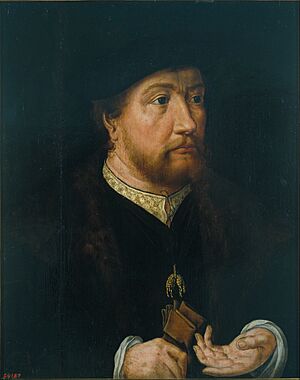
One historian, L.J. van der Klooster, argued that the inscription was added later and was wrong. He pointed out that the man in the drawing looks like Henry III in other portraits. He also noted that the woman in the foreground looks like Henry's third wife, Mencía de Mendoza, and that she is riding a mule, which was common for women in Spain (Mencía was Spanish).
However, another historian, C.W. Fock, argued that the inscription and coats of arms were carefully planned and should be trusted. She said that while the man might resemble Henry III, no portraits of John V are known, and Henry could have looked like his father. She also noted that women riding mules appeared in Dutch art before Mencía's time.
Fock believes the tapestry shows John V and Elisabeth, as the inscription states. She suggests the two extra women in the background are Elisabeth's sister Matilda (who gave up her inheritance to Elisabeth) and John V's sister Anne (who was married to the last Count of Katzenelnbogen). This would emphasize the family's claim to the rich County of Katzenelnbogen, which was very important at the time.
Today, the Netherlands Institute for Art History states that the picture depicts Henry III with his wife Mencía de Mendoza and two deceased wives. They believe the identification as John V was based on a later, incorrect inscription. The mystery of who is truly depicted continues to be debated by historians.
Marriage and Children
John married Landgravine Elisabeth of Hesse-Marburg in Marburg on 11 February 1482. Elisabeth was born in May 1466 and died in Cologne on 17 January 1523. She was the daughter of Landgrave Henry III the Rich of Hesse-Marburg and Countess Anne of Katzenelnbogen.
John and Elisabeth had the following children:
- Count Henry III (born 12 January 1483 – died 14 September 1538). He became count after his uncle Engelbert II died in 1504.
- He married Countess Françoise Louise of Savoy-Vaud in 1503.
- He married Claudia of Chalon in 1515.
- He married Mencía de Mendoza y Fonseca in 1524.
- John (born 3 November 1484 – died 15 August 1504?).
- Ernest (born 9 April 1486 – died 12 October 1486).
- Count William I the Rich (born 10 April 1487 – died 6 October 1559). He became count after his father died in 1516.
- He married Countess Walburga of Egmont in 1506.
- He married Countess Juliane of Stolberg-Wernigerode in 1531.
- Elisabeth (born 1488 – died 3 June 1559). She married Count John III of Wied in 1506.
- Mary (born February 1491 – died 1547). She married Count Jobst I of Holstein-Schauenburg-Pinneberg in 1506.
Elisabeth and Mary had a double wedding at Siegen Castle in February 1506. There was a big celebration with a banquet in the city hall in Siegen. The city council even donated 16 oxen and 19 pigs for the feast! The celebrations were very grand, with lots of expensive fabrics bought for the weddings.


